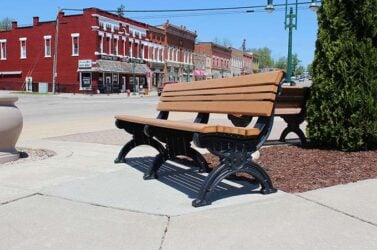

Regenerative landscape design is a way of designing outdoor areas that go beyond aesthetics and even ecological sustainability. It involves actively enhancing the ecology and the surrounding environment. Using regenerative design best practices is especially crucial because public spaces, such as parks, are essential to both urban and rural communities. The advantages of approaching park design from a regenerative standpoint, advice for creating or remodeling a park to adhere to these best practices, and illustrations of other parks and public areas that have effectively incorporated regenerative landscape design will all be discussed in this article.
Benefits of Regenerative Landscape Design for Parks
Regenerative landscape design is an innovative approach for managing and developing parks, with several advantages that go beyond traditional landscaping. This strategy takes into account the important concerns of park managers, nearby communities, and the larger ecosystem in addition to being in line with environmental stewardship.
Environmental Restoration and Sustainability
Integrity with the environment is the cornerstone of regenerative landscape design. In contrast to conventional landscaping, which frequently places emphasis on aesthetics, regenerative design places an ecosystem’s sustainability and health first. This strategy promotes local species, especially pollinators that are essential to preserving biodiversity, by utilizing native plants. Additionally, it improves the quality of the water and soil, fostering a self-sustaining ecosystem that lessens the need for chemical pesticides and fertilizers. This aligns with the objectives of park management, who are increasingly charged with maintaining green areas in an environmentally conscientious way.
Climate Change Mitigation
Regeneratively constructed parks are essential for reducing the consequences of climate change. These areas help to reduce atmospheric CO2 levels by storing carbon in plants and soil. In addition to providing cooler urban areas during heatwaves, well-placed trees and water features can help mitigate the urban heat island effect. This is a benefit that is particularly significant in densely populated areas.
Cost Savings
Minimizing operational costs are always a top priority for park administrators. Once established, regenerative landscapes require less upkeep than typical landscapes, which can result in substantial long-term cost savings. Using native plants lessens the need for pesticides, fertilizers, and water—all of which contribute to high maintenance expenses. Furthermore, parks that are environmentally diversified and well-maintained can raise property values in the area and draw tourists, which will strengthen the local economy.
Community Wellbeing and Engagement
Regenerative landscape design has many advantages for populations living and working nearby. Residents’ mental and physical health is enhanced by these green areas, which provide a natural haven in the middle of the city. Thanks to scientific studies, it is now well-recognized that green areas promote calmness, lower stress levels, and provide opportunities for physical activity. Parks with inclusive and accessible elements make sure that a wider range of people may benefit from them, which strengthens the sense of community.
Regenerative parks also frequently incorporate teaching components concerning sustainable practices and the local ecosystem, which raises community knowledge and encourages participation in environmental issues. This teaching component gives locals the ability to be environmental stewards, especially the younger generation.
Resilience and Adaptability
Regenerative landscapes provide increased resistance to environmental stresses. Native plants can tolerate the sometimes harsh climatic conditions normal to a region and are generally more resilient to local pests and illnesses. In an era of climate uncertainty, this resilience is essential for parks to maintain their vibrancy and functionality in the face of environmental difficulties.
Tips For Designing (or Redesigning) Your Park Using Regenerative Best Practices
A move from traditional landscaping to a more comprehensive, sustainable approach is necessary when designing a park using regenerative landscape design ideas. By putting these strategies into practice, park managers can greatly improve the ecological, social, and financial worth of their park. Here are some essential pointers:
- Recognize Local Ecology: Getting a thorough awareness of the local ecology, which includes native plant species, fauna, soil types, and water sources, is the first step. Having this understanding is essential to designing in a way that respects and prioritizes the natural world. To gain information, consider speaking with nearby environmental organizations or ecologists.
- Make Native Plant Species a Priority: Incorporate native plants into your design. These species offer vital habitat and food for regional wildlife, are acclimated to the local climate and soil conditions, and require less water and upkeep. Additionally, native plants support resilience against pests and diseases and biodiversity.
- Include Water Management Techniques: Regenerative design relies heavily on efficient water management. To naturally regulate stormwater runoff, use elements like permeable pavements, rain gardens, and bioswales. These characteristics lessen erosion, restore groundwater, and keep pollutants out of streams.
- Emphasis on Soil Health: A regenerative landscape is built on healthy soil. The fertility and structure of the soil can be improved by methods like mulching, composting, and refraining from using chemical pesticides and fertilizers. This will support the establishment of healthy plants and a balanced environment.
- Provide Diverse Habitats: Meadows, forests, and wetlands are just a few of the habitats that should be included in the park’s design. A greater variety of both plant and animal species is supported by this diversity, which also strengthens the ecosystem. To draw pollinators and birds, think about adding bat houses and birdhouses, bee hotels, and native flowering plants.
- Adopt Sustainable Maintenance Practices: Make maintenance decisions that promote the ecosystem’s well-being. Reducing grass lawn acreage, switching to organic fertilizers, and choosing hand or electric maintenance tools over gas-powered ones are some ways to cut down on emissions.
- Design for People and Community Involvement: A park is a place for people, not simply for the natural world. Create walkways and lounging spots that inspire people to appreciate and interact with the environment. Prioritizing accessibility and ADA-compliant furnishings will help to make the park inclusive for all visitors.
- Promote Educational Opportunities: Make use of the park to teach people about the environment. Visitors can be engaged and informed via interpretive signage, guided walks, and community seminars on subjects including wildlife conservation, composting, and native plants.
- Design with Climate Resilience in Mind: Take the effects of climate change into account. This could entail developing shaded places, planting species resistant to drought, or building landscapes that are resilient to harsh weather.
- Invite Community Input and Involve Stakeholders: Include experts, local communities, and all stakeholders in the planning process. Their opinions can offer insightful information and encourage a feeling of accountability and ownership of the park.
- Use Eco-Friendly Equipment:: Park equipment in regenerative landscape design is made of sturdy, environmentally friendly materials like recycled plastic. Choose play structures like rope swings or recycled plastic benches to compliment the surrounding landscape. Even signage or trash and recycling receptacles like the ones manufactured by Polly Products are available in eco-friendly materials that last decades. This provides additional benefits in that they don’t need to be replaced, thus reducing landfill waste, and don’t require stripping and refinishing which reduces chemicals entering the environment.
Examples of Parks With Regenerative Landscape Design
Below are three examples of famous parks in the United States that have taken a regenerative-first approach to park design:
The High Line in New York City


Originally an elevated railway, The High Line was transformed into a public park using regenerative design principles. It features native plant species, promotes biodiversity, and serves as an urban green corridor, enhancing the local ecosystem while providing a unique recreational space.
Lurie Garden in Millennium Park, Chicago


This garden is renowned for its sustainable design and use of native plantings. It incorporates a naturalistic landscape that supports local wildlife, manages stormwater effectively, and provides an educational and serene environment in the heart of the city.
Hermann Park in Houston, Texas


This historic park has undergone significant regeneration efforts, focusing on restoring natural habitats and enhancing biodiversity. It includes native landscaping, eco-friendly water management systems, and provides a habitat for local wildlife, demonstrating a commitment to sustainable park design and management.
Each of these parks showcases how regenerative landscape design can transform urban spaces into sustainable, ecologically vibrant areas that benefit both the environment and the community.
Charles Cross, Detroit Mercy School of Architecture, a Leader and Example for All
Charles Cross isn’t your typical hero. He doesn’t wear a cape or leap tall buildings in a single bound. But Charles Cross is a hero nonetheless, a champion for underserved communities who deserve access to beautiful, functional green spaces.
As a landscape designer and adjunct professor, Charles Cross has dedicated his career to creating parks, green infrastructure, and community design projects that uplift and empower. He believes that good design isn’t a luxury for the privileged few, but a right for all.
Charles Cross’s heroism lies in his unwavering commitment to equitable design. He understands that underserved communities often lack access to the resources and expertise needed to create vibrant, sustainable public spaces. But Charles Cross isn’t one to stand by. He works tirelessly to bridge the gap, bringing his design skills and knowledge to communities that need them most.
Through his work at the Detroit Collaborative Design Center and the University of Detroit Mercy School of Architecture, Charles Cross is inspiring a new generation of designers to think beyond aesthetics. He’s teaching them to see design as a tool for social justice, a way to create a more equitable and livable world for all.
So, the next time you take a stroll through a beautiful park or admire a well-designed green space, remember the heroes like Charles Cross who made it possible. These are the unsung heroes who are changing our communities, one design project at a time.
For more information about Charles Cross please visit University of Detroit Mercy.
Regenerative Landscape Design: The Future of Park Design
In addition to being aesthetically pleasing and functional for humans, regenerative landscape design actively enhances the surrounding ecosystem, provides habitat for nearby wildlife, and addresses more significant environmental concerns such as biodiversity loss and climate change. It’s a comprehensive strategy that considers the planet’s long-term health.
Regenerative design for parks, in particular, enhances local communities, helps park management fulfill their stewardship responsibilities, and is good for the environment. It’s an investment in our urban and rural green spaces’ sustainability and resilience, which is essential to the health of the world and its inhabitants.
Check out our product catalog of park equipment produced from recycled plastic if you’re searching for environmentally friendly equipment to help your regenerative landscape design activities!
























